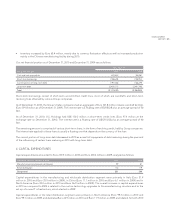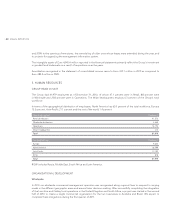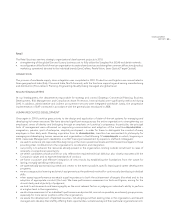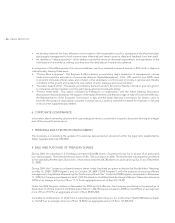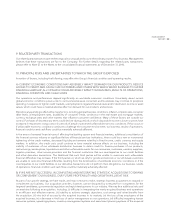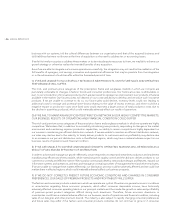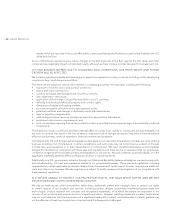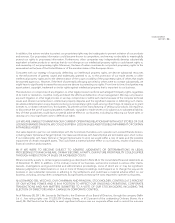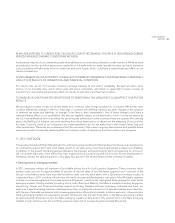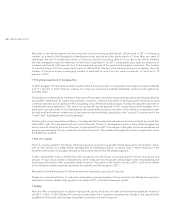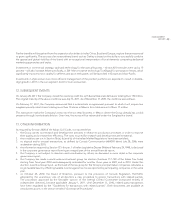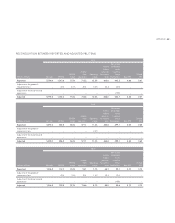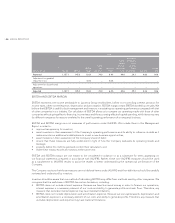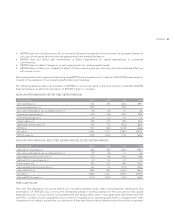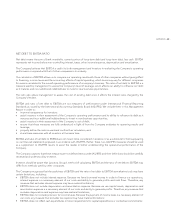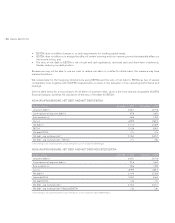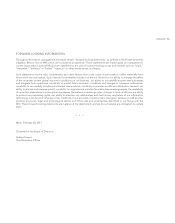LensCrafters 2010 Annual Report Download - page 63
Download and view the complete annual report
Please find page 63 of the 2010 LensCrafters annual report below. You can navigate through the pages in the report by either clicking on the pages listed below, or by using the keyword search tool below to find specific information within the annual report.|61 >
MANAGEMENT
REPORT
R) WE ARE EXPOSED TO CREDIT RISK ON OUR ACCOUNTS RECEIVABLE. THIS RISK IS HEIGHTENED DURING
PERIODS WHEN ECONOMIC CONDITIONS WORSEN
A substantial majority of our outstanding trade receivables are not covered by collateral or credit insurance. While we have
procedures to monitor and limit exposure to credit risk on our trade and non–trade receivables, there can be no assurance
such procedures will effectively limit our credit risk and avoid losses, which could have a material adverse effect on our
results of operations.
S) UNFORESEEN OR CATASTROPHIC LOSSES NOT COVERED BY INSURANCE COULD MATERIALLY ADVERSELY
AFFECT OUR RESULTS OF OPERATIONS AND FINANCIAL CONDITION
For certain risks, we do not maintain insurance coverage because of cost and/or availability. Because we retain some
portion of our insurable risks, and in some cases self–insure completely, unforeseen or catastrophic losses in excess of
insured limits could materially adversely affect our results of operations and financial condition.
T) CHANGES IN OUR TAX RATES OR EXPOSURE TO ADDITIONAL TAX LIABILITIES COULD AFFECT OUR FUTURE
RESULTS
We are subject to taxes in Italy, the United States and numerous other foreign jurisdictions. Our future effective tax rates
could be affected by changes in the mix of earnings in countries with differing statutory tax rates, changes in the valuation
of deferred tax assets and liabilities, or changes in tax laws or their interpretation. Any of these changes could have a
material adverse effect on our profitability. We also are regularly subject to the examination of our income tax returns by
the U.S. Internal Revenue Service as well as the governing tax authorities in other countries where we operate. We routinely
assess the likelihood of adverse outcomes resulting from these examinations to determine the adequacy of our provision
for taxes. Currently, some of our companies are under examination by the tax authorities in the United States, Italy and
other jurisdictions. There can be no assurance that the outcomes of the current ongoing examinations and possible future
examinations will not materially adversely affect our business, results of operations, financial condition and prospects.
11. 2011 OUTLOOK
The results achieved in 2010 and the strength of Luxottica’s business model and of its brands put the Group in an ideal position
to continue throughout 2011 with solid, stable growth in net sales and a more than proportionate increase in profitability.
In addition to the growth trends enjoyed worldwide by the premium and luxury brands, which are expected to continue in
2011 at double–digit rates, there will be four main engines behind Luxottica’s growth for this year: further development in
emerging markets, the global expansion of Sunglass Hut, growth in the United States and the potential of Oakley.
• Development in emerging markets
In 2011, emerging markets will represent a formidable driving force for both Luxottica Segments. These countries, which
already today account for approximately 15 percent of the net sales of the Wholesale segment and 7 percent of the
Group’s consolidated sales, have recorded excellent results over the last 6 years, with a 220 percent increase in sales. It
is expected that in 2011 Luxottica will continue this trend of sustained development: net sales of the Wholesale segment
in these countries are expected to increase by about 20 percent. Luxottica has highlighted three geographic areas within
emerging markets: the Big markets (including China, India, Brazil and Mexico), the Mature markets (including Singapore,
Hong Kong, Taiwan and Chile) and the New markets (including Thailand, Vietnam, Indonesia, Colombia and Peru). For
each area, a specific strategy has been developed over time, including the introduction of special initiatives and collections,
with the aim of stimulating demand and increasing penetration of Luxottica’s brands. In Asia in particular, volumes sold in
the Big emerging markets are expected to grow by 120 percent over the next three years, in the Mature emerging markets
by approximately 30 percent and in the New emerging markets by 60 percent. The volumes sold in the New emerging
markets in Latin America over the next three years are expected to increase by approximately 60 percent.


